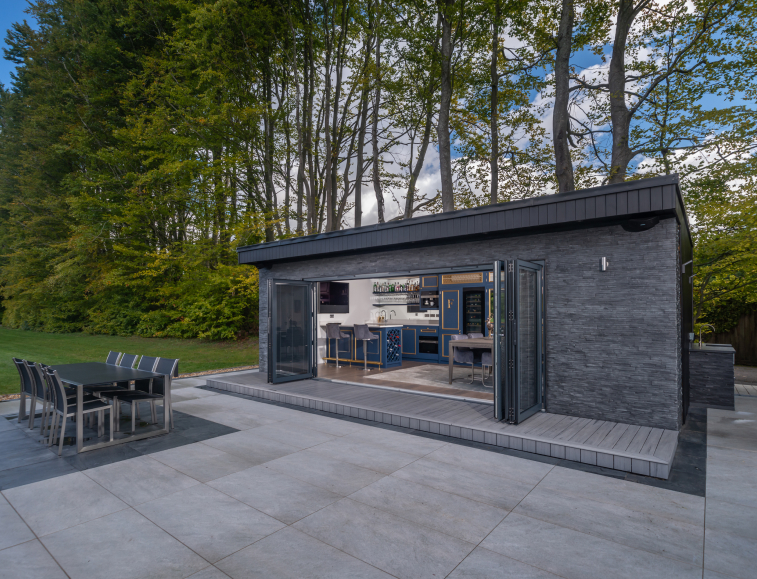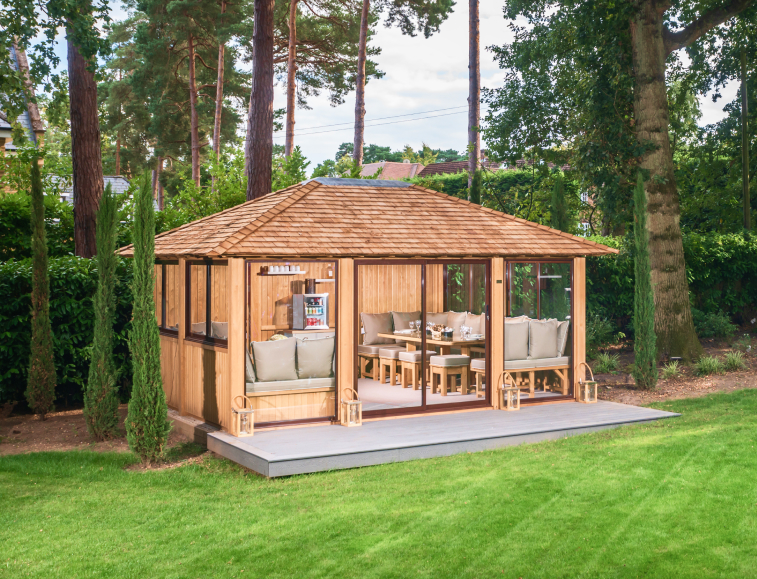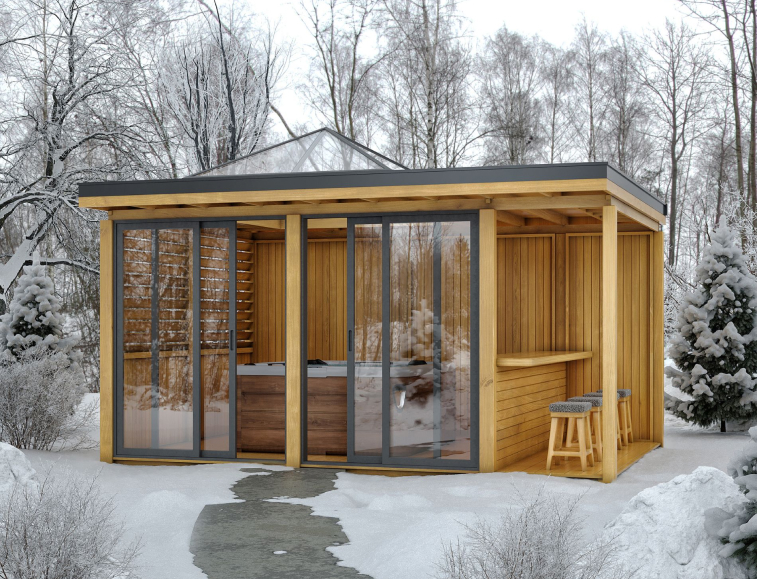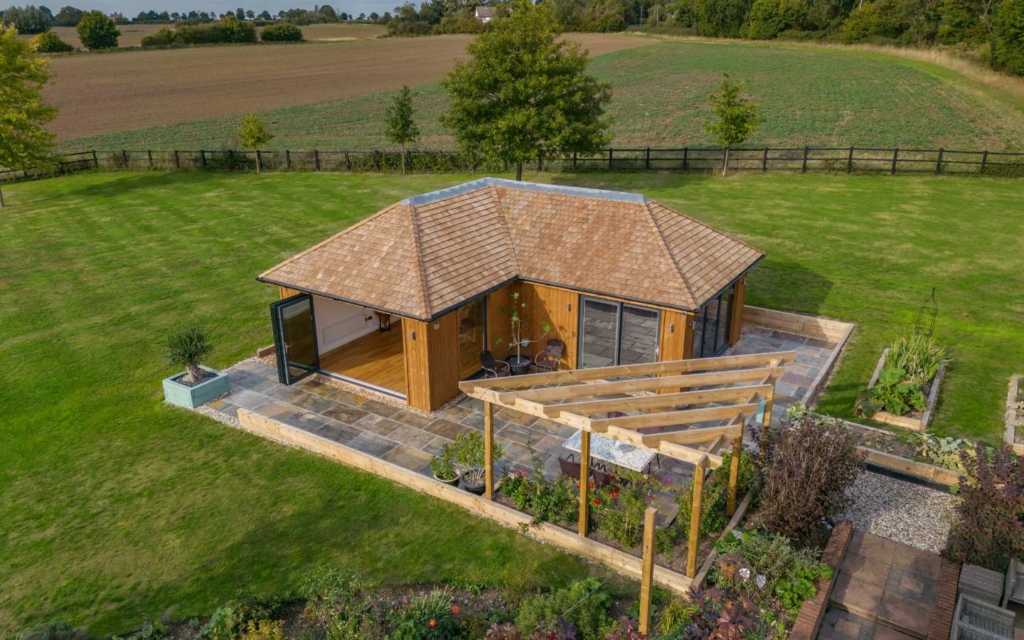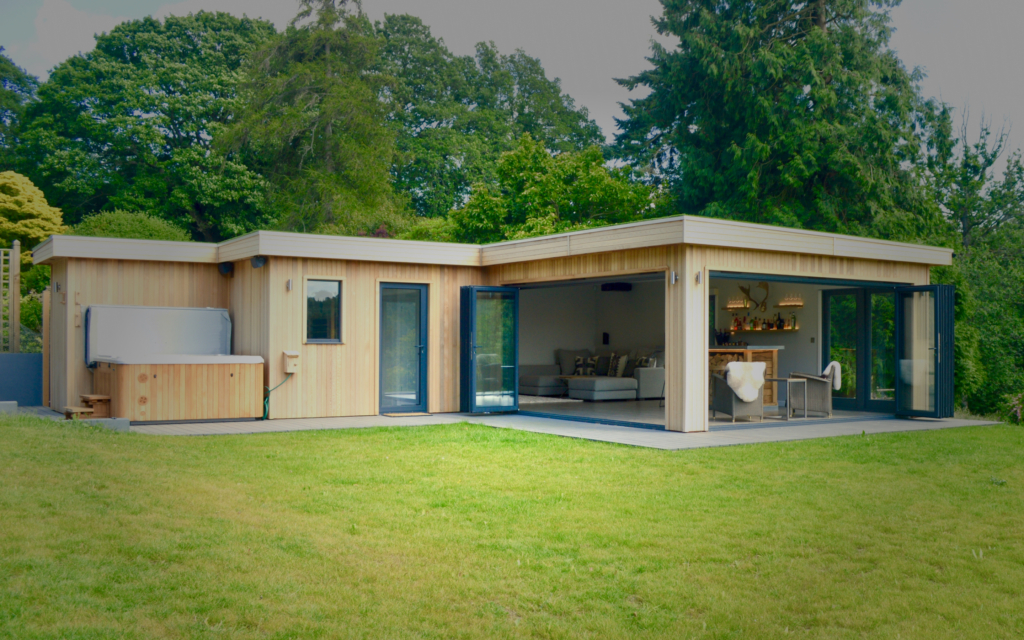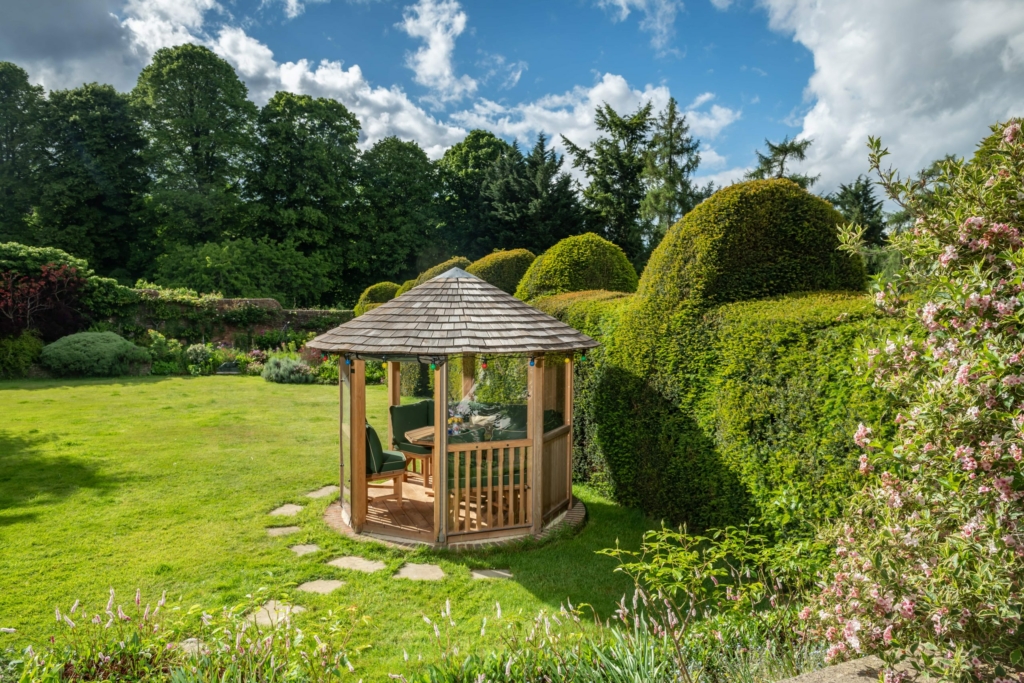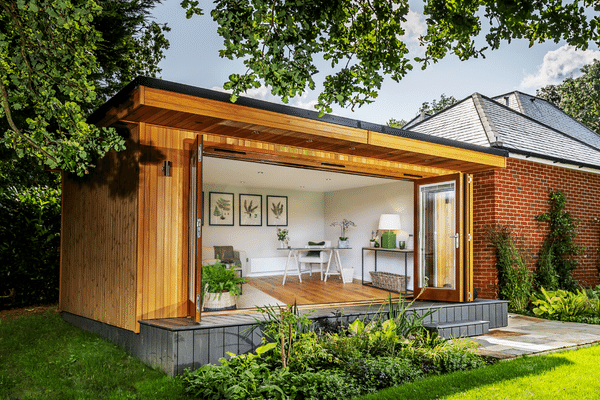Cladding is the extra layer of material that goes on the exterior of your garden room to protect it from the elements, while also providing additional soundproofing and insulation. Cladding provides effective weather-proofing to ensure you can use your garden all year-round and preserve the condition of your luxury garden building. Yet, cladding can be so much more than a functional feature. Choose from a variety of cladding colours and materials, and add a stylish appeal to your outdoor space. Here are just a few garden room cladding ideas, many of which you can find in garden rooms provided by Crown Pavilions.
Thermowood Cladding
Thermowood cladding is an environmentally-friendly option since the production process uses heat and water instead of chemicals. The way it’s made also ensures that it does not react to changes in humidity therefore avoiding any cracking, shrinking or expanding of the wood which could cause structural damage. Thermowood is a durable option which can withstand harsh weather conditions without rot and decay. The right wood treatment can keep your cladding looking fresh and enrich the colour, preventing it from going a dull grey colour after a few years. In fact, Thermowood cladding has a lifespan of up to 30 years but can last even longer if treated properly!
Thermwood cladding usually has visible knots and grain lines which creates an organic, natural feel that complements the natural surroundings of your garden. At Crown Pavilions, our luxury garden rooms are designed using Thermowood cladding as we believe that it offers the most effective protection against wind and rain.
Cedar Cladding
Typically sourced from Canada, Cedar is a durable softwood timber that makes a great material to use for your garden room cladding. Cedar cladding is long-life and offers better weather resistance than most other types of timber. It’s often recommended to seal the Cedarwood to ensure no water is absorbed and, when done properly, can have a lifespan of 40-60 years without decay.
Cedar is typically knot-free with a deep red colour for a classic aesthetic that will look stunning in any garden. At Crown Pavilions, we offer premium grade Canadian Western Red Cedar cladding as an optional upgrade to enhance your garden room and make a statement, while keeping your building structurally-sound.
Siberian Larch Cladding
Siberian Larch originates from the forests of Siberia in Russia and is most popular for its beautiful colouring and texture. Siberian Larch is a magnificent pale golden colour and would make a fabulous addition to a minimalist space and look lovely in a south facing garden. However, due to its light colouring, Siberian Larch requires regular maintenance and staining to ensure it does not turn grey after a few years.
Siberian Larch trees take a very long time to grow which, in turn, yields one of the hardest softwoods and dense timbers, making it ideal for weather-proofing your garden room. Additionally, the resin in the wood creates a natural barrier against rot and decay.
Painted Cladding
If you’re looking to create a bright garden room or you can’t find cladding in the desired colour, there’s no reason why you can’t paint over wooden or uPVC cladding. Just make sure you get the right type of paint so that it doesn’t chip, flake or run off. Oil-based paints are usually recommended for outdoor materials like cladding.
Painting your garden room cladding allows you to get creative with colours, patterns and finishes. Choose from glossy, satin or matte, or you could even create your very own wall mural; that will be sure to catch your neighbours’ attention! At Crown Pavilions, we offer a range of painted cladding options, including Forest Green, French Blue, Olive Green, Dove White, Midnight Black or French Grey.
Note that painted cladding may require a high level of maintenance and repainting every few years due to weathering from rain, snow and UV rays.
Compostable Cladding
In recent years, we have seen an increase in biodegradable materials being used in construction, including compostable cladding. Compostable cladding is usually made up of recycled paper waste, wood fibres and water to create a type of hard plastic. The idea is that it uses up recycled materials which would otherwise be left to landfill but will eventually biodegrade using industrial composting methods after it’s served its purpose.
Compostable cladding has the same characteristics of both wood and plastic; it can be poured and moulded like plastic, but when dry can be sanded down, cut and shaped like wood. Its natural fibres create durability to a certain extent but need added protection, just like wood needs treating, otherwise it will biodegrade much quicker than you would want.
Metal Cladding
When it comes to metal cladding, aluminium and steel are the most common metals used. Metal cladding provides reliable protection from weather corrosion while also adding stability to the garden room structure. One of the best things about metal cladding is that it’s non-combustible, making it a low fire hazard. There are also a number of different styles available, such as matte finishes, rustic looks, various colours and even eco-friendly recycled metals.
Unlike wooden cladding, metal cladding does not require staining however may need some maintenance to prevent rusting. If installed correctly and taken care of, metal cladding can last 35+ years.
High-Pressure Laminates
High-Pressure Laminates, or HPLs for short, are made from layers of wood and paper, bonded with heat and pressure using resin. This type of material is not typically used for larger buildings as it can be highly flammable but is fit-for-purpose for a garden building, especially as chemicals can be added to give the cladding fire-resistant properties.
HPLs are lightweight and durable, and easily cut to size so make the perfect solution for custom builds. HPLs are UV resistant so you can expect very little fading over the years, and are also easy to clean so you can keep your garden room looking great at all times.
You can even use HPL cladding to add a unique element to your garden room and go for a bold colour or funky design – a trendy feature for any contemporary garden.
Render Finishes
Rendering is slightly different to cladding and can be a less expensive option for protecting your garden room. Rendering involves covering your exterior wall with cement, lime or acrylic, similar to plastering. Depending on how well the rendering is done, it can last 20+ years. Lime is a good option for rendering as it’s flexible and does not crack whereas cement can expand and shrink with changing weather conditions.
If you do choose render finishes over cladding for your garden room, we recommend choosing a pre-coloured render so you don’t need to touch up on the paint job or carry out avoidable maintenance.
Slate & Brick Cladding
Slate and brick cladding is the perfect solution if you’re looking to maintain a natural aesthetic to suit your garden setting. There are a variety of slate and brick finishes to choose from, including limestone, marble, quartz, granite, sandstone and other natural stones. A stacked stone look can add a modern twist or large slabs make for a seamless finish.
Slate and brick are heavy to work with and can be more expensive than other cladding options, for both the materials and the labour, but the pay-off is worth it. It’s long-lasting, durable, easy to clean and, of course, looks incredible. Check out our Clarence garden room model for some more inspiration.
uPVC Cladding
uPVC is a type of hard plastic that is typically used for conservatories, window and door frames since it’s highly weather-resistant and fire-retardant. uPVC cladding does not rot and can usually last around 20 years, rarely requiring structural maintenance. However, there are limited options for this material and it usually comes in white or an oak effect, which does not look as chic as real wood alternatives. The white colour of uPVC also gets dirty quite quickly therefore needs regular cleaning to keep it looking its best.
Cement Board Cladding
According to building regulations, garden rooms that are built within 1m of boundary lines must be made from non-combustible materials. If this applies to your building, cement board cladding is a fantastic option since it’s low combustible and poses less of a fire hazard than other cladding materials. Cement board cladding is also at low risk of fungal growth, making it a robust solution that will last for many years.
How to Clad your Garden Room
At Crown Pavilions, our TRADA (Timber Research And Development Association)-certified team will work with you to create the luxury garden room of your dreams. Our specialist engineers and creative designers are there to help you turn your ideas into reality.
We build made-to-measure garden rooms in the materials of your choice, including the finest cladding to suit your space. High-grade Thermowood cladding is included when you go for one of our standard garden room models, however we also offer the option to upgrade to cladding of your choice or go bespoke.

